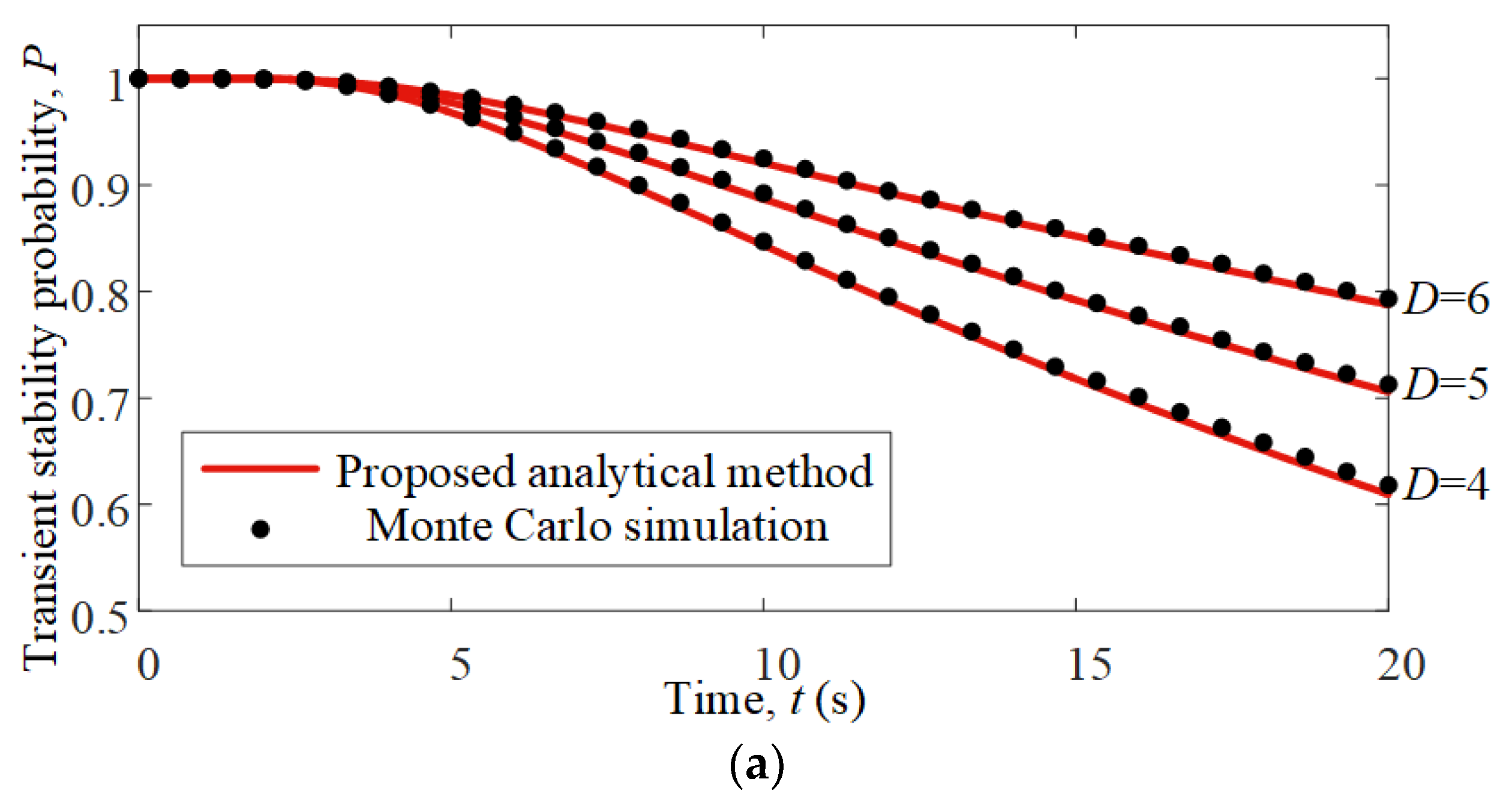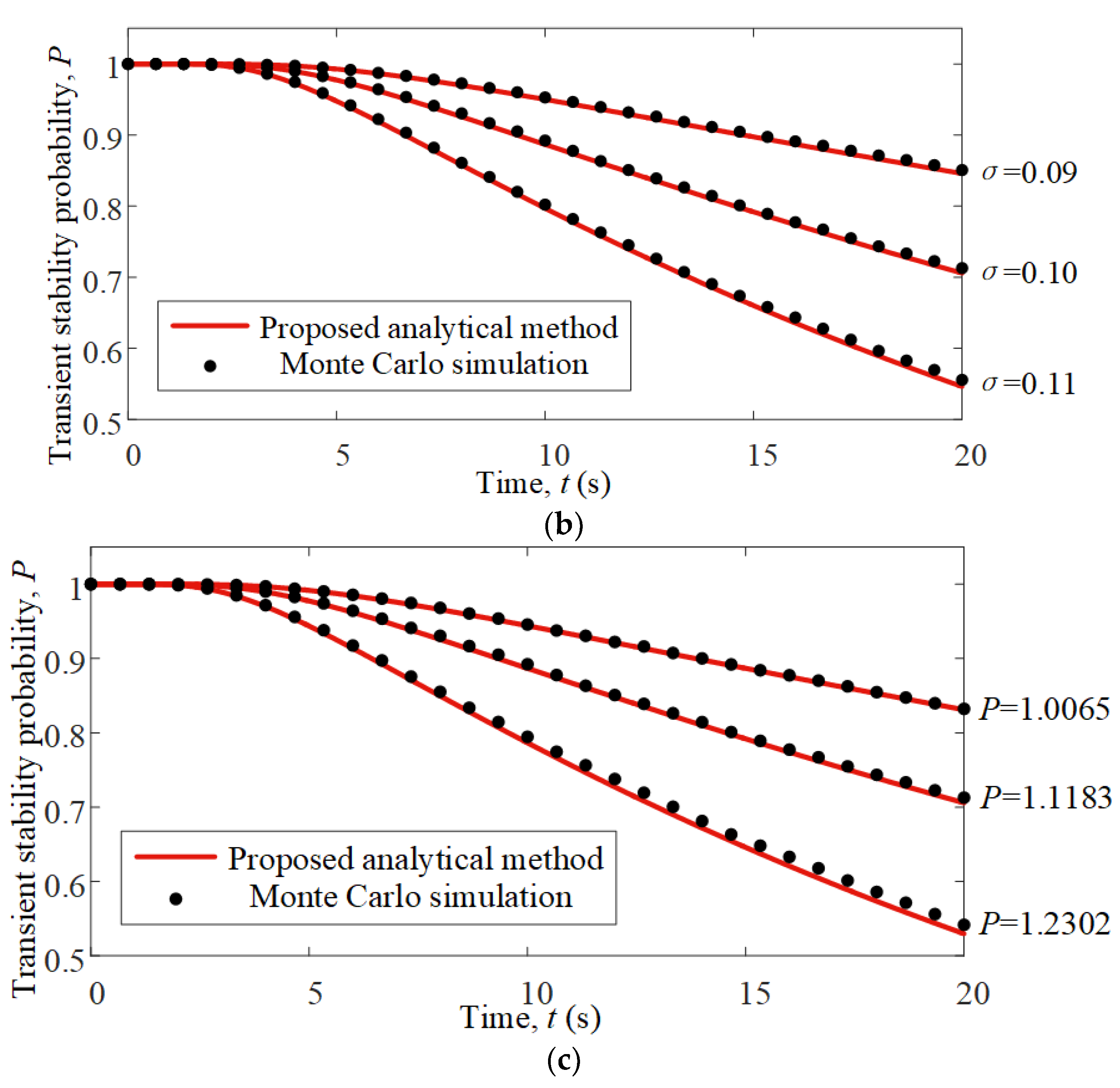Stochastic Stability Analysis of the Power System with Losses
Abstract
1. Introduction
2. Power Systems with Losses
2.1. A Model of Power System with Losses
2.2. Energy Function of Power System with Losses
2.3. Stability Assessment of Power System with Losses
3. Stochastic Stability of Power System Considering the Losses under Stochastic Continuous Disturbances
3.1. Stochastic Power System Model Based on SDEs
3.2. Stability Probability of Power System with Losses under Stochastic Continuous Disturbances
4. Stochastic Stability Assessment for Power Systems Considering Losses under Stochastic Continuous Disturbances
4.1. Stochastic Power System Model in Quasi-Hamiltonian Form
4.2. Equivalent Itō Stochastic Differential Equation for the System Energy of Power Systems with Losses under SCDs
4.3. Analytical Method for Solving the Stability Probability
4.4. Procedure for the Stochastic Stability Analysis of a Power System with Losses
5. Simulation Case
5.1. Modified SMIB System and Its Critical Potential Energy
5.2. Stochastic Averaging Method
5.3. Comparisons of Stability Probability under Different Parameters
6. Conclusions
- (1)
- Based on the presented quasi-Hamiltonian model of a power system with losses under SCDs, the quasi-Hamiltonian theory is shown here to be useful in analyzing nonlinear stochastic dynamics in power systems with losses under SCDs.
- (2)
- The analytical method put forward, which determines the stability probability of a power system with losses under SCDs, agree well with the results of the Monte Carlo simulation. The proposed method is also shown to have a clearer impact mechanism and have higher efficiency.
- (3)
- The comparisons of stability probability under different parameters are performed, from which insights to improve the stability probability of power systems with losses under SCDs can be obtained.
Acknowledgments
Author Contributions
Conflicts of Interest
References
- Gan, C.; Wu, J.H.; Hu, Y.H.; Yang, S.Y.; Cao, W.P.; Guerrero, J.M. New integrated multilevel converter for switched reluctance motor drives in plug-in hybrid electric vehicles with flexible energy conversion. IEEE Trans. Power Electron. 2017, 32, 3754–3766. [Google Scholar] [CrossRef]
- Zhou, Y.C.; Li, Y.G.; Liu, W.D.; Yu, D.S.; Li, Z.C.; Liu, J.M. The stochastic response surface method for small-signal stability study of power system with probabilistic uncertainties in correlated photovoltaic and loads. IEEE Trans. Power Syst. 2017, 32, 4551–4559. [Google Scholar] [CrossRef]
- Zhu, Q.; Chen, J.; Zhu, L.; Duan, X.; Liu, Y. Wind speed prediction with spatio-temporal correlation: A deep learning approach. Energies 2018. to be published. [Google Scholar]
- Calif, R.; Schmitt, F.G.; Huang, Y.X. Multifractal description of wind power fluctuations using arbitrary order hilbert spectral analysis. Physica A 2013, 392, 4106–4120. [Google Scholar] [CrossRef]
- Zhou, T.P.; Sun, W. Optimization of battery-supercapacitor hybrid energy storage station in wind/solar generation system. IEEE Trans. Sustain. Energy 2014, 5, 408–415. [Google Scholar] [CrossRef]
- Jia, H.J.; Mu, Y.F.; Qi, Y. A statistical model to determine the capacity of battery-supercapacitor hybrid energy storage system in autonomous microgrid. Int. J. Electr. Power Energy Syst. 2014, 54, 516–524. [Google Scholar] [CrossRef]
- Perez-Ortiz, M.; Jimenez-Fernandez, S.; Gutierrez, P.; Alexandre, E.; Hervas-Martinez, C.; Salcedo-Sanz, S. A review of classification problems and algorithms in renewable energy applications. Energies 2016, 9, 607. [Google Scholar] [CrossRef]
- Ehsani, M.; Falahi, M.; Lotfifard, S. Vehicle to grid services: Potential and applications. Energies 2012, 5, 4076–4090. [Google Scholar] [CrossRef]
- Wang, T.; Bi, T.; Wang, H.; Liu, J. Decision tree based online stability assessment scheme for power systems with renewable generations. CSEE J. Power Energy Syst. 2015, 1, 53–61. [Google Scholar] [CrossRef]
- Zhang, J.Y.; Ju, P.; Yu, Y.P.; Wu, F. Responses and stability of power system under small gauss type random excitation. Sci. China-Technol. Sci. 2012, 55, 1873–1880. [Google Scholar] [CrossRef]
- Qiu, J.; Shahidehpour, S.M.; Schuss, Z. Effect of small random perturbations on power-systems dynamics and its reliability evaluation. IEEE Trans. Power Syst. 1989, 4, 197–204. [Google Scholar] [CrossRef]
- Ma, J.; Song, Z.X.; Zhang, Y.X.; Zhao, Y.; Thorp, J.S. Robust stochastic stability analysis method of dfig integration on power system considering virtual inertia control. IEEE Trans. Power Syst. 2017, 32, 4069–4079. [Google Scholar] [CrossRef]
- Odun-Ayo, T.; Crow, M.L. Structure-preserved power system transient stability using stochastic energy functions. IEEE Trans. Power Syst. 2012, 27, 1450–1458. [Google Scholar] [CrossRef]
- Wang, K.; Crow, M.L. The fokker-planck equation for power system stability probability density function evolution. IEEE Trans. Power Syst. 2013, 28, 2994–3001. [Google Scholar] [CrossRef]
- Hua, K.; Mishra, Y.; Ledwich, G. Fast unscented transformation-based transient stability margin estimation incorporating uncertainty of wind generation. IEEE Trans. Sustain. Energy 2015, 6, 1254–1262. [Google Scholar] [CrossRef]
- Zarate-Minano, R.; Anghel, M.; Milano, F. Continuous wind speed models based on stochastic differential equations. Appl. Energy 2013, 104, 42–49. [Google Scholar] [CrossRef]
- Ghanavati, G.; Hines, P.D.H.; Lakoba, T.I. Identifying useful statistical indicators of proximity to instability in stochastic power systems. IEEE Trans. Power Syst. 2016, 31, 1360–1368. [Google Scholar] [CrossRef]
- Milano, F.; Zárate-Miñano, R. A systematic method to model power systems as stochastic differential algebraic equations. IEEE Trans. Power Syst. 2013, 28, 4537–4544. [Google Scholar] [CrossRef]
- Yuan, B.; Zhou, M.; Li, G.; Zhang, X.P. Stochastic small-signal stability of power systems with wind power generation. IEEE Trans. Power Syst. 2015, 30, 1680–1689. [Google Scholar] [CrossRef]
- Wang, X.; Chiang, H.D.; Wang, J.; Liu, H.; Wang, T. Long-term stability analysis of power systems with wind power based on stochastic differential equations: Model development and foundations. IEEE Trans. Sustain. Energy 2015, 6, 1534–1542. [Google Scholar] [CrossRef]
- Ju, P.; Li, H.; Pan, X.; Gan, C.; Liu, Y.; Liu, Y. Stochastic dynamic analysis for power systems under uncertain variability. IEEE Trans. Power Syst. 2017, PP, 1. [Google Scholar] [CrossRef]
- Dong, Z.Y.; Zhao, J.H.; Hill, D.J. Numerical simulation for stochastic transient stability assessment. IEEE Trans. Power Syst. 2012, 27, 1741–1749. [Google Scholar] [CrossRef]
- Chen, L.C.; Zhu, W.Q. First passage failure of dynamical power systems under random perturbations. Sci. China-Technol. Sci. 2010, 53, 2495–2500. [Google Scholar] [CrossRef]
- Chen, L.C.; Zhu, W.Q. First passage failure of quasi non-integrable generalized hamiltonian systems. Arch. Appl. Mech. 2010, 80, 883–893. [Google Scholar] [CrossRef]
- Ju, P.; Li, H.; Gan, C.; Liu, Y.; Yu, Y.; Liu, Y. Analytical assessment for transient stability under stochastic continuous disturbances. IEEE Trans. Power Syst. 2018, 33, 2004–2014. [Google Scholar] [CrossRef]
- Zhu, W.Q. Nonlinear stochastic dynamics and control in hamiltonian formulation. Appl. Mech. Rev. 2006, 59, 230–248. [Google Scholar] [CrossRef]
- Zhu, W.Q.; Yang, Y.Q. Stochastic averaging of quasi-nonintegrable-hamiltonian systems. J. Appl. Mech.-Trans. Asme 1997, 64, 157–164. [Google Scholar] [CrossRef]
- Hsiao-Dong, C.; Chia-Chi, C.; Cauley, G. Direct stability analysis of electric power systems using energy functions: Theory, applications, and perspective. Proc. IEEE 1995, 83, 1497–1529. [Google Scholar] [CrossRef]
- Ortega, R.; Galaz, M.; Astolfi, A.; Yuanzhang, S.; Shen, T. Transient stabilization of multimachine power systems with nontrivial transfer conductances. IEEE Trans. Autom. Control 2005, 50, 60–75. [Google Scholar]
- Mao, X. Stochastic Differential Equations and Applications; Elsevier: Amsterdam, The Netherlands, 2007. [Google Scholar]
- Gan, C.; Zhu, W. First-passage failure of quasi-non-integrable-hamiltonian systems. Int. J. Non-Linear Mech. 2001, 36, 209–220. [Google Scholar] [CrossRef]






© 2018 by the authors. Licensee MDPI, Basel, Switzerland. This article is an open access article distributed under the terms and conditions of the Creative Commons Attribution (CC BY) license (http://creativecommons.org/licenses/by/4.0/).
Share and Cite
Li, H.; Ju, P.; Gan, C.; Wu, F.; Zhou, Y.; Dong, Z. Stochastic Stability Analysis of the Power System with Losses. Energies 2018, 11, 678. https://doi.org/10.3390/en11030678
Li H, Ju P, Gan C, Wu F, Zhou Y, Dong Z. Stochastic Stability Analysis of the Power System with Losses. Energies. 2018; 11(3):678. https://doi.org/10.3390/en11030678
Chicago/Turabian StyleLi, Hongyu, Ping Ju, Chun Gan, Feng Wu, Yichen Zhou, and Zhe Dong. 2018. "Stochastic Stability Analysis of the Power System with Losses" Energies 11, no. 3: 678. https://doi.org/10.3390/en11030678
APA StyleLi, H., Ju, P., Gan, C., Wu, F., Zhou, Y., & Dong, Z. (2018). Stochastic Stability Analysis of the Power System with Losses. Energies, 11(3), 678. https://doi.org/10.3390/en11030678





